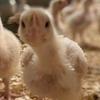Allowing poultry access to vegetated, woody spaces will benefit poultry welfare. One system that incorporates the production of vegetation and livestock, including poultry, is called a silvopasture system. Woody vegetation can provide a source of income for producers while providing preferred habitat for chickens.
Silvopasture systems are part of an agroforestry approach, combining production of vegetation with the production of animals, which can be applied for poultry too. In this newsletter, we will highlight the benefits for chickens to have access to a range with vegetation other than grass.
The jungle fowl: ancestors of the modern-day chicken
Modern day chickens show many of the same motivations and behaviors as their ancestor: the jungle fowl. As the name implies, jungle fowl are a forest-dwelling species. They show diurnal behavioral rhythms, where they are active and forage (search for food) on the forest floor in the early morning and late afternoon, and rest in the middle of the day and at night (perching in trees).
Jungle fowl prefer a forested habitat, with trees and shrubs. Just like their ancestors, laying hens and broiler chickens prefer overhead, natural shelter on their range. The preference for vegetated outdoor spaces compared to just open grass pastures still is present in today’s chicken strains.
This preference for vegetated areas serves a few functions:
- Overhead vegetation deters predatory birds.
- Trees and bushes allow chickens to hide from predators that look for prey in forested areas.
- Vegetation mitigates weather extremes: protecting from heat, cold, wind, and rain to different extents.
- Vegetation (compared to just grass) allows for a more varied diet.
Benefits of improved range use
- Opportunity for exercise and increased activity
- Improved leg strength
- Reduced risk for footpad dermatitis
- Greater opportunity to show species-important behaviors
- Reduced point pollution due to more homogenous distribution of feces
Ranging behavior
In backyard or small-scale flocks, chickens often have access to an outdoor space. In contrast, in most commercial housing conditions chickens do not have access to the outdoors. However, outdoor access is part of some production systems, like USDA-certified organic, or certified pasture-raised birds.
When providing access to an outdoor space is an option, the outdoor space should be designed such that birds will actually use the space, so that the full benefits of the space are realized. These outdoor spaces can vary, although most commercial operations will provide open grass pastures, while small enterprises or hobby farmers may have a wider variety of options.
Commercially-grown birds don’t range much or far
In commercial practice, we see that chickens may not make use of their pasture very much. This can be partially due to the lack of vegetation.
Researchers found that only 5-13% of broiler chickens flocks will range outside at any given time. Birds that do go outside often stay very close to the house.
In our study in commercial, fast-growing broiler chickens, we saw that generally more birds would be ranging when they had natural overhead cover from trees, than when they had access to open grassland.
This was especially apparent in the afternoon where 5% of the flock would range outdoors, compared to 1% in the open pasture flocks. We also observed that birds with trees on their range would roam a little further from their house, compared to birds that only had open grass pasture. However, these numbers are still relatively low, because overhead cover is not the only factor impacting range use.
Some factors that impact range use
Natural shelter is preferred over man-made shelters. Any shelter is preferred over no shelter.
- Weather conditions and time of day
Chickens are quite picky about the weather, and will avoid rain, harsh wind, direct sun and midday heat if they can. If vegetation or shade panels are present on hot sunny days, more chickens will range outside. Most birds will be outside in the early morning and late afternoon, mirroring their ancestors’ diurnal rhythm.
Experiences when birds are young can impact birds’ behavior later in life. Free-range use can increase with age, and will increase more if birds were allowed outdoors at an earlier age.
Birds that are more anxious or fearful tend to stay indoors. Early life experiences can impact fear, and our research showed that broilers on silvopastures (wooded free ranges) were less fearful than birds that just had access to open grass ranges.
In laying hens, larger flocks generally do not range outside as much compared to smaller flocks. Synchronization of behavior may play a role here, or the contrast between indoor and outdoor conditions. For instance the bright and windy outdoors may be less appealing to a chicken housed in a relatively dark, climate-controlled commercial farm, while in small coops (like in the picture on the left) the contrast between inside and outside is less pronounced.
Differences in range use are found between poultry types (broiler chickens or laying hens) and within poultry types. These can be caused by differences in activity levels and fearfulness.
Summary
Like their ancestor the Jungle Fowl, modern chickens will range outdoors when given the opportunity, and given shelter or natural overhead cover from bushes and trees.
Poultry flocks that get the opportunity to range outdoors can benefit in terms of health and behavioral opportunities. However, many factors impact ranging behavior, including shelters, weather, time of day, early life experiences, fear, group size and genetic strain.
One component that could stimulate poultry to use the range more, is providing natural vegetation other than grass. Although range use can still be limited even when having access to trees on the range, range use does increase.


























